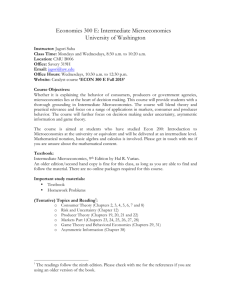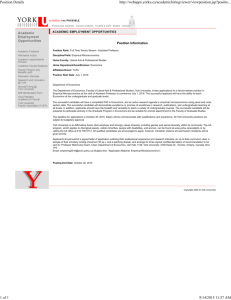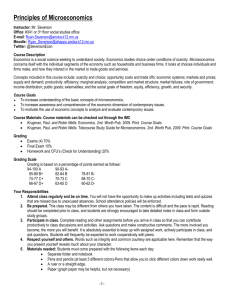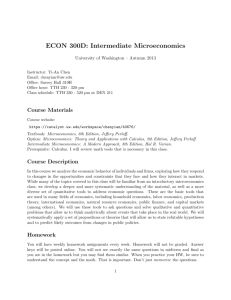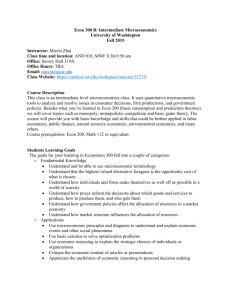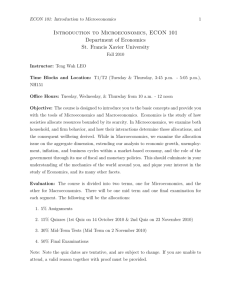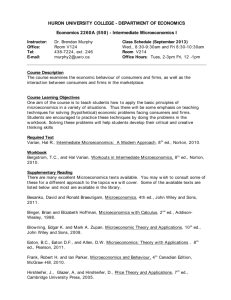Department of Economics - University of California, Berkeley
advertisement
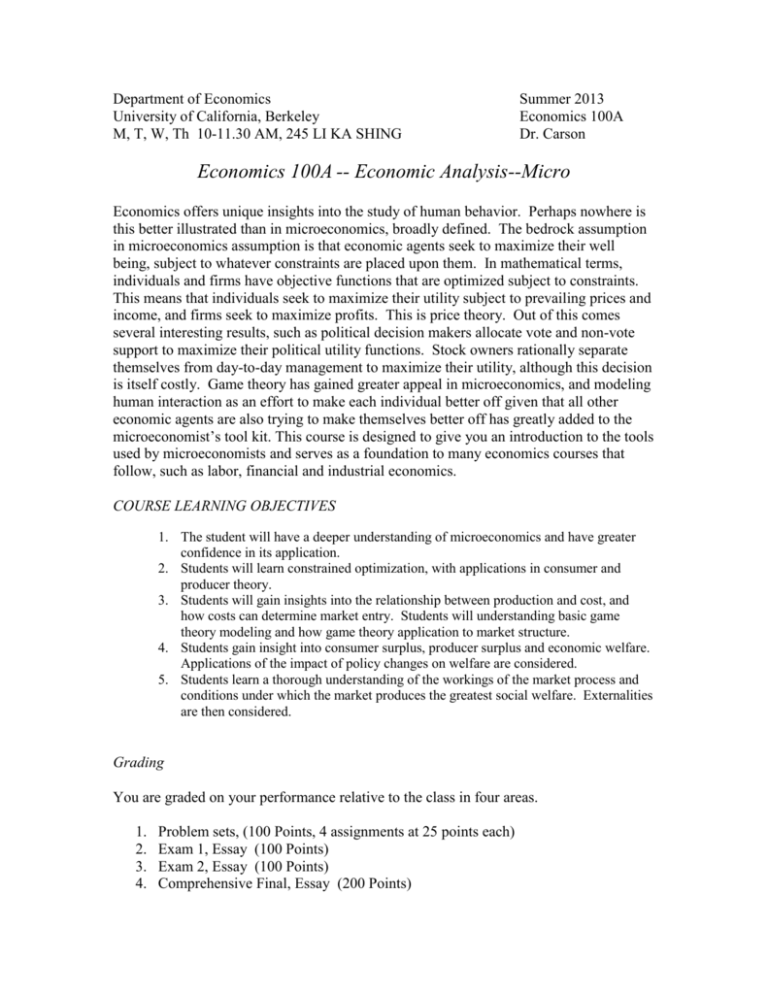
Department of Economics University of California, Berkeley M, T, W, Th 10-11.30 AM, 245 LI KA SHING Summer 2013 Economics 100A Dr. Carson Economics 100A -- Economic Analysis--Micro Economics offers unique insights into the study of human behavior. Perhaps nowhere is this better illustrated than in microeconomics, broadly defined. The bedrock assumption in microeconomics assumption is that economic agents seek to maximize their well being, subject to whatever constraints are placed upon them. In mathematical terms, individuals and firms have objective functions that are optimized subject to constraints. This means that individuals seek to maximize their utility subject to prevailing prices and income, and firms seek to maximize profits. This is price theory. Out of this comes several interesting results, such as political decision makers allocate vote and non-vote support to maximize their political utility functions. Stock owners rationally separate themselves from day-to-day management to maximize their utility, although this decision is itself costly. Game theory has gained greater appeal in microeconomics, and modeling human interaction as an effort to make each individual better off given that all other economic agents are also trying to make themselves better off has greatly added to the microeconomist’s tool kit. This course is designed to give you an introduction to the tools used by microeconomists and serves as a foundation to many economics courses that follow, such as labor, financial and industrial economics. COURSE LEARNING OBJECTIVES 1. The student will have a deeper understanding of microeconomics and have greater confidence in its application. 2. Students will learn constrained optimization, with applications in consumer and producer theory. 3. Students will gain insights into the relationship between production and cost, and how costs can determine market entry. Students will understanding basic game theory modeling and how game theory application to market structure. 4. Students gain insight into consumer surplus, producer surplus and economic welfare. Applications of the impact of policy changes on welfare are considered. 5. Students learn a thorough understanding of the workings of the market process and conditions under which the market produces the greatest social welfare. Externalities are then considered. Grading You are graded on your performance relative to the class in four areas. 1. 2. 3. 4. Problem sets, (100 Points, 4 assignments at 25 points each) Exam 1, Essay (100 Points) Exam 2, Essay (100 Points) Comprehensive Final, Essay (200 Points) Professor's Office Hours Prerequisite Economics 1 (Introduction to Microeconomics and Macroeconomics) is the only prerequisite for the course. Some familiarity with the broad outlines of U.S. economic history is presumed. Required Textbooks Besanko, David and Ronald Braeutigam, Microeconomics, 4th Edition. John Wiley Publishers, 2011. I really do not care which edition you use. You just need access to the problem sets. Grading Grades are assigned according to your point accumulation relative to the class high. Grades are assigned according to the following scale: Grade A AB+ B BC+ C CD+ D DE Percent 93% 90% 87% 84% 81% 78% 75% 70% 67% 64% 60% Below 60% POLICY ON SCHOLASTIC DISHONESTY: Scholastic dishonesty has been a problem in recent years. When legal code is necessary to maintain academic honesty and social interaction, social bounds of reciprocity are eliminated. Ergo, it is expected that the highest forms of honesty and respect for others be adhered too. Outside of this, the University expects a student to maintain a high standard of individual honor in all scholastic work. STUDENT CLASSROOM CONDUCT: Be nice. Failure to be cool with me, the instructor, or other students may adversely affect your grade. If you sometimes feel like you're stepping over the lines of social decorum, you probably are, so step back and reevaluate, because it may detract from our classroom environment. Other than that, let's just hang out and learn as much as we can this semester. Outline Chapter 1 Chapter 2 Chapter 3 Chapter 4 Chapter 5 Exam 1 Chapter 6 Chapter 7 Chapter 8 Chapter 9 Chapter 10 Exam 2 Chapter 11 Chapter 12 Chapter 13 Chapter 14 Chapter 15 Chapter 16 Chapter 17 Final Analyzing Economic Problems Demand and Supply Analysis Consumer Preferences and the Concept of Utility Consumer Choice The Theory of Demand 1-25 26-72 73-102 103-149 150-191 Inputs and Production Functions Costs and Cost Minimization Cost Curves Perfectly Competitive Markets Competitive Markets: Applications 200-244 245-284 285-326 327-385 386-437 Monopoly and Monopsony Capturing Surplus Market Structure and Competition Game Theory and Strategic Behavior Risk and Information General Equilibrium Theory Externalities and Public Goods 438-484 485-527 528-570 571-603 604-647 648-696 697-728 This is a tentative syllabus and outline. I reserve the right to make changes. However, all changes will be announced in class. If you miss a day, you are responsible to be informed of any changes to this syllabus.


